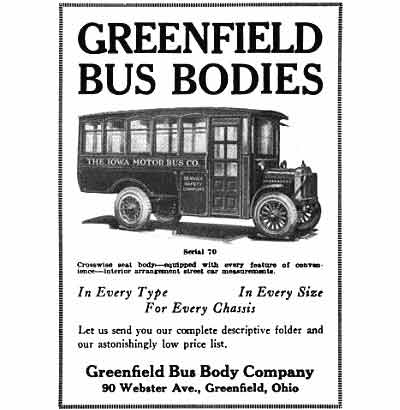Frederick Douglas Patterson (1871–1932) was an American entrepreneur known for the Greenfield-Patterson automobile of 1915, built in Ohio. He later converted his business to the Greenfield Bus Body Company.
While in college at Ohio State University, he was the first African-American to play on its football team. He returned to Greenfield to join his father in his carriage business, which became C.R. Patterson and Sons.

The younger man saw opportunity in the new horseless carriages, and converted the company in the early 1900s to manufacture automobiles, making 150 of them.
Development of an automobile began in 1914 and the first Patterson-Greenfield rolled out of the company’s Washington St. facility on Sept. 23, 1915. Priced at $850, the Patterson-Greenfield was offered as a touring or roadster and featured a 30hp Continental 4-cylinder engine, full floating rear axle, cantilever springs, demountable rims, electric starting and lighting and a split windshield for ventilation.
Later he shifted to making buses and trucks and renamed his company as Greenfield Bus Body Company. After Patterson's death in 1932, his son kept the business going through much of the Great Depression, finally closing it in 1939.

Named after the noted abolitionist, Frederick Douglas Patterson was born in 1871 as the youngest of four children of Josephine Utz (aka Outz) and Charles Richard Patterson. He had an older brother Samuel. Their father was an ex-slave who had escaped to Greenfield, Ohio from Virginia shortly before the American Civil War.

After getting established as a blacksmith in town, Charles had married Josephine Utz, a young local white woman. By the time Frederick was born, his father had a successful carriage business with a partner. The Pattersons encouraged the education of their children: Samuel, two daughters, and Frederick.
Just before the Civil War, Charles Patterson left slavery and headed north, bringing blacksmithing skills he learned in Virginia. Not long after settling in, Patterson began working at a carriage company. By 1870 he was a foreman and by 1873, Patterson had gone into business with J.P. Lowe, a white carriage maker.
The State of Ohio’s 1888 Bureau of Labor Statistics Report lists J.P. Lowe & Co., carriages, etc. with a staff of 10. It is believed that Patterson became a partner in the business that was popularly known as Lowe & Patterson, although its legal name remained J.P. Lowe & Co. until 1893 when Patterson bought out Lowe's share in the business and reorganized as C.R. Patterson, Son & Co. to reflect the involvement of Samuel C. Patterson, Charles’ youngest son.
Frederick graduated from the old Greenfield High School in 1888 and went on to Ohio State University. While at the university, he played on the football team in his junior year in 1891, the first African American to do so. He withdrew from college in his senior year before graduating, taking a job as a high school history teacher in Louisville, Kentucky. It was a different career than his father's business, where his older brother was already working.
Frederick's brother Samuel entered the family business with their father. In 1893, Charles bought out his 20-year partner, J.P. Lowe, and renamed the carriage business C.R. Patterson & Son Company. In 1897, Charles became ill. By this time, Samuel had died. Frederick resigned his teaching position to return and help operate the family business. His father renamed it C.R. Patterson and Sons, and the younger man took on an increasing role.
Patterson got married in 1899 and had a family, including a son Postell Patterson.
After his father died in 1910, Frederick D. Patterson took over the business. Seeing the rise of "horseless carriages", he started development of the first Patterson-Greenfield car, completed in 1915. His two styles competed with Henry Ford's model T and sold for about $850. He was the first African-American to own and operate a car manufacturing company.

After producing about 150 vehicles, and having difficulty getting financing for expansion, Patterson decided to change his business rather than compete head on with the major Detroit industry.

He built bodies for trucks and buses set upon a chassis made by Ford or GM. In 1920, he changed the name of his company to Greenfield Bus Body Company.
Between 1922 and 1925 advertisements and press releases for the Greenfield Bus Body Co. appeared in the nation’s commercial vehicle trade journals. Although the firm's factory was located on Washington Street, near Lafayette, the 90 Webster Ave. address refers to its shipping address, which was located across from the railroad depot on the outskirts of town.

He built strong business relationships with numerous school districts, which became steady customers.
The Crash and Great Depression had a devastating effect on his company, as widespread financial problems caused his customers to cut back on bus orders. Patterson died in 1932. His son Postell Patterson, who had worked with him, closed the business in 1939.
No Patterson-Greenfield autos are known to exist, but some of his father's C.R. Patterson & Sons Company carriages have survived.
Note: There was another unrelated Dr. Frederick Douglass Patterson born 30 years later, who became president of Tuskegee University and the found of the United Negro College Fund.
Part of the Court.rchp.com 2017 Black History Month Series
Article text republished from Wikipedia with additional source material from AfricaSource and Coachbuilt.










